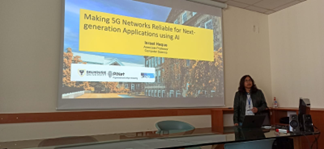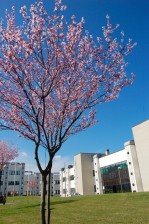When a System Specialist Meets Big Data Experts
This Blog shares my experience visiting the KDD research lab at the National Research Council (CNR) in Pisa. The lab has knowledge discovery and data mining expertise for efficient mobility-based social services (e.g., transportation, human mobility). Dr. Mirco Nanni and his team hosted me for a two-week visit to their research lab. The team has expertise in sequential data analytics and the development of explainable and trustworthy models. On the other hand, I lead a research lab called Programmable and Intelligent Networking (PINet) that focuses on developing systems for mobile cellular networks (e.g., 5G/6G), AI and Big Data, and cloud and edge. We also leverage AI to solve some practical systems problems. In the following, I will share how my visit creates complementary research initiatives, including developing new systems, supervising and exchanging students, and applying for relevant research grants. I will conclude the Blog with my social and cultural experience in PISA and nearby cities.

I arrived at PISA on a beautiful sunny afternoon and indulged in local seafood in the famous La Ghiotteria. The next day, I received a warm welcome from Mirco and his students. Mirco and I initially discussed various topics, including my research seminar on May 27, 2024. This seminar outlined two groups of works: AI for systems and systems for AI.
The first phase focuses on predictive maintenance in 5G Radio Access Networks (RANs) to support latency-critical applications like autonomous vehicles. These applications heavily rely on high-speed 5G radio communications that may be affected by surrounding weather conditions. Data-driven prediction allows providers to take precautions in the case of anticipated failures. However, existing solutions fail to successfully capture the spatio-temporal properties of radio signals and weather features. These solutions are also not generalized. Thus, we develop GenTrap, a novel generalized radio link failure prediction framework that employs Transformer as the temporal feature extractor and incorporates Graph Neural Network (GNN) spatial context capture. GenTrap can be integrated into any existing prediction model for better performance and generalizability. Simba also leverages GNN and Transformer and develops a root cause analyzer in 5G Radio Access Networks (RANs). Their performance confirmed effectiveness in making 5G RANs reliable to support the above-mentioned applications.
The second phase of the talk highlighted a couple of projects on developing systems for AI and Big Data. stream2gym is a real-time data analytics system for applications like fraud detection and Internet of Things (IoT) data processing. The system is easy to configure and use, making it a viable solution for stream processing application developers, which was missing in existing literature. GreenEdge, on the other hand, is the first initiative to measure the resource (e.g., energy, CPU) usage of classical ML, deep learning, and large language models during inference on edge devices like Raspberry PI and NVIDIA Jetson Nano. The findings will enable users to make informed decisions on AI models and the corresponding edge device selection for edge applications like self-driving cars. The seminar attendees included researchers from CNR and the University of PISA and brought thought-provoking questions and comments.
Mirco and I had another round of meetings to finalize possible collaborative research projects following my seminar. Also, a couple of attendees contacted me to access our data and discuss further collaboration opportunities. Mirco arranged a meeting with a post-doctoral researcher, Dr. Francesco Spinnato, who has expertise in developing explainable models for sequential traffic that models like GenTrap and Simba process. We brainstormed on developing an idea of extending GenTrap with explainability support. Members from both labs have already started working on this collaborative project. The developed explainable model will remarkably support 5G service providers in knowing the reasoning behind AI models. We also finalized another project on the performance characterization of two sustainable AI models for mobility applications. This project can be a master’s thesis; thus, we plan to recruit a student at CNR or Dalhousie University. Finally, we planned for potential joint grant applications using the complementary expertise from two labs.
Social and cultural experience: I have been to PISA before, but returning to this city of history was a rewarding experience. I used to have lunch at the CNR canteen with other lab mates during my stay in CNR. I met a new colleague from CNR or the University of PISA almost daily. The lunchtime conversations extended beyond technical topics, e.g., football, food, history, shopping, etc. I learned a lot from them. For instance, Mirco mentioned how the entire PISA is divided into four quadrants by the Arno River and the central bridge. I explored all four quadrants while enjoying local gelato, seafood, pizza, and ravioli. I also enjoyed exploring local shops to pick souvenirs and Italian fabrics. In addition to visiting the iconic leaning tower of Pisa, I visited another historical Italian landmark, Florence.


Overall, it was a fun-filled two-week visit to CNR that allowed me to share our research and learn from the KDD lab. However, the unique nature of this visit was the socialization with colleagues while learning Italian culture. Exploring the beautiful Pisa and Florence gracefully completed a memorable trip I will always cherish.
I look forward to returning to the lab and the city in the future. Ciao!!!!!!

